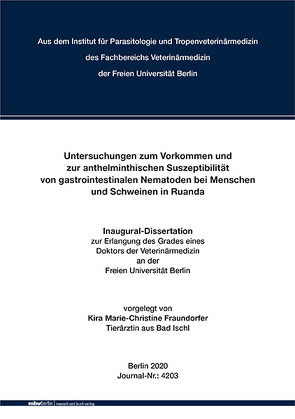
Soil transmitted helminths (STHs), namely Ascaris lumbricoides, Trichuris trichiura and the hookworms A. duodenale and N. americanus are common parasites in almost two billion humans globally and pose a great threat to human health, especially in schoolchildren. Strategic treatment against STHs becomes increasingly important in many endemic countries. School children are particularly vulnerable and STHs can inhibit school performance or, in more severe cases, lead to malnutrition and growth stunting. In Rwanda, preventive chemotherapy is applied once or twice a year to school children and most members of the target group are regularly treated.
In this present study, stool samples from school children aged six to ten years belonging to twelve schools and stool samples from pigs from the subdistricts of the southern province of Rwanda were examined using Mini-FLOTAC chamber to detect eggs of one or multiple of the STH species mentioned above. Fecal egg count reduction (FECR) and cure rate (CR) were calculated to assess whether worm populations in Rwanda showed any signs for development of resistance against benzimidazoles. In 2014, almost 2000 stool samples were examined. During the follow-up in the next year, additional 400 samples from four out of the twelve schools were collected and examined. Children which had been enrolled in the study brought a fresh stool sample to school, which was then collected. In 2014, the children were also clinically examined. Additionally, a blood sample was taken and finally the children were treated with Albendazol under supervision. A follow-up stool sample was collected seven to ten days after the first treatment. The same procedure was undertaken in 2015 but children were not again clinically examined nor had to provide a blood sample. In 2014, additional stool samples from pigs, living in sheds next to the house as the participating children, were collected and examined for eggs of Ascaris suum, Trichuris suis or gastrointestinal strongyles. For further investigations, samples were kept from which DNA was extracted in the laboratory in Berlin and molecular analysis of β-tubulin single nucleotide polymorphisms in Ascaris sp. was performed.
The overall prevalence for Ascaris sp. before the first round of deworming was 40 %, it decreased to 13 % after treatment. The results of microscopy in the present study showed signs of reduced efficacy of the BZ albendazole in nine out of 10 examined schools. The FECR in the affected schools was significally below the treshold suggested by Vercruysse et al. (2011). Overall it ranged from zero to 99.56 %. The CRs ranged from 33 to 100 %. However, the molecular biological results were not in line with the microscopic results since in none of the analyzed samples SNPs associated with BZ resistance were found.
The prevalence of Ascaris sp. in pigs ranged from 18,5 - 80,8 %, of T. suis from 0 - 28,8 % and prevalences of hookworm ranged from 72,2 – 94,2 %. In the as urban claimed villages of Ngoma and Tumba there were no pigs living at the time our study was conducted.
The results of the study suggest that resistance might have developed in the southern province of Rwanda and treatment has to be adapted accordingly to prevent further selection of resistant worm populations. This should be a priority in future prevention programs.
For better evaluation of the prevalence of resistant population, further research needs to be conducted throughout the entire country. As this study has failed to show any of the suggested SNPs associated with benzimidazole resistance, further investigations into the mechanisms of resistance in Ascaris sp. are suggested since it is possible that SNPs are found at other sites of the genome such as in additional β-tubulin isotypes. In addition, it is possible that BZ metabolism leads to resistance by reducing the concentration of active drug with the worms. Future research will be needed to identify the BZ resistance mechanisms in Ascaris sp.
Aktualisiert: 2022-12-31
> findR *
MEHR ANZEIGEN
Bücher zum Thema DNA cloning, rwanda
Sie suchen ein Buch über DNA cloning, rwanda? Bei Buch findr finden Sie eine große Auswahl Bücher zum
Thema DNA cloning, rwanda. Entdecken Sie neue Bücher oder Klassiker für Sie selbst oder zum Verschenken. Buch findr
hat zahlreiche Bücher zum Thema DNA cloning, rwanda im Sortiment. Nehmen Sie sich Zeit zum Stöbern und finden Sie das
passende Buch für Ihr Lesevergnügen. Stöbern Sie durch unser Angebot und finden Sie aus unserer großen Auswahl das
Buch, das Ihnen zusagt. Bei Buch findr finden Sie Romane, Ratgeber, wissenschaftliche und populärwissenschaftliche
Bücher uvm. Bestellen Sie Ihr Buch zum Thema DNA cloning, rwanda einfach online und lassen Sie es sich bequem nach
Hause schicken. Wir wünschen Ihnen schöne und entspannte Lesemomente mit Ihrem Buch.
DNA cloning, rwanda - Große Auswahl Bücher bei Buch findr
Bei uns finden Sie Bücher beliebter Autoren, Neuerscheinungen, Bestseller genauso wie alte Schätze. Bücher zum
Thema DNA cloning, rwanda, die Ihre Fantasie anregen und Bücher, die Sie weiterbilden und Ihnen wissenschaftliche
Fakten vermitteln. Ganz nach Ihrem Geschmack ist das passende Buch für Sie dabei. Finden Sie eine große Auswahl
Bücher verschiedenster Genres, Verlage, Autoren bei Buchfindr:
Sie haben viele Möglichkeiten bei Buch findr die passenden Bücher für Ihr Lesevergnügen zu entdecken. Nutzen Sie
unsere Suchfunktionen, um zu stöbern und für Sie interessante Bücher in den unterschiedlichen Genres und Kategorien
zu finden. Unter DNA cloning, rwanda und weitere Themen und Kategorien finden Sie schnell und einfach eine Auflistung
thematisch passender Bücher. Probieren Sie es aus, legen Sie jetzt los! Ihrem Lesevergnügen steht nichts im Wege.
Nutzen Sie die Vorteile Ihre Bücher online zu kaufen und bekommen Sie die bestellten Bücher schnell und bequem
zugestellt. Nehmen Sie sich die Zeit, online die Bücher Ihrer Wahl anzulesen, Buchempfehlungen und Rezensionen zu
studieren, Informationen zu Autoren zu lesen. Viel Spaß beim Lesen wünscht Ihnen das Team von Buchfindr.
